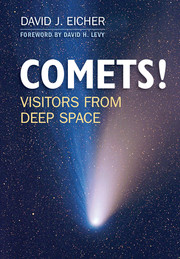Book contents
- Frontmatter
- Dedication
- Contents
- List of Figures
- List of Plates
- Foreword
- Preface
- Acknowledgments
- 1 Strange Lights in the Sky
- 2 Great Comets
- 3 What Are Comets?
- 4 Comets of the Modern Era
- 5 Comets in Human Culture
- 6 Where Comets Live
- 7 The Expanding Science of Comets
- 8 Observing Comets
- 9 Imaging Comets
- Glossary
- Bibliography
- Index
- Plate Section
7 - The Expanding Science of Comets
Published online by Cambridge University Press: 05 October 2013
- Frontmatter
- Dedication
- Contents
- List of Figures
- List of Plates
- Foreword
- Preface
- Acknowledgments
- 1 Strange Lights in the Sky
- 2 Great Comets
- 3 What Are Comets?
- 4 Comets of the Modern Era
- 5 Comets in Human Culture
- 6 Where Comets Live
- 7 The Expanding Science of Comets
- 8 Observing Comets
- 9 Imaging Comets
- Glossary
- Bibliography
- Index
- Plate Section
Summary
The science of understanding comets has changed dramatically in the 60 years since Fred Whipple hypothesized the basic model of cometary nuclei and Jan Oort suggested the existence of the large cloud that most comets call home. Over the past 20 years some really interesting twists and turns in the road have confronted planetary scientists: The distinction between comets and asteroids has blurred significantly and is based in some ways on where these icy bodies happen to be at the present time rather than intrinsic differences in their makeup.
The past decade has also witnessed an explosion of science, conjecture, and speculation about the role comets have played in our own existence. Did comets provide substantial amounts of water to Earth, thereby making the development of life on our planet either possible or easier? And even more dramatically, astronomers have focused on the organic molecules discovered in comets for years now, wondering whether they may have deposited organics onto early Earth that may have led to the development of life. We’ve seen that comets and asteroids are destroyers of life when they cause large impacts on our planet. Were they also the promoters of life? Do we owe our very existence to them?
- Type
- Chapter
- Information
- COMETS!Visitors from Deep Space, pp. 134 - 153Publisher: Cambridge University PressPrint publication year: 2013



